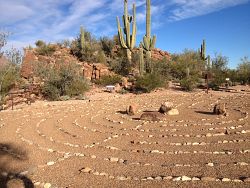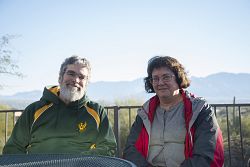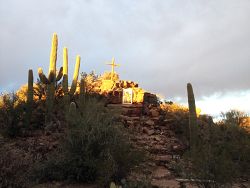Science and theology combine at Tucson's Vatican Observatory; workshop leads to spiritual reflection
Friday, Feb. 06, 2015

Juliana Boerio-Goates
Photo 1 of 3
The Redemptorist Renewal Center includes an outdoor labyrinth. The rock cluster that is visible has a set of petroglyphs in the upper left corner.Courtesy photos/Juliana Boerio-Goates
By Dr. Juliana Boerio-Goates
Special to the Intermountain Catholic
Controversies between faith and science make good headlines, but they do not generally reflect either good theology or good science. That was the message I heard last week in Tucson, Ariz. during a workshop on Faith and Astronomy organized by the Vatican Observatory. Yes, the Vatican has an astronomical observatory, actually two of them – the site near Tucson, the other in Castel Gandolfo, outside Rome, Italy. Both observatories are staffed by a group of astronomers who are also Jesuit priests and brothers.
At the workshop, I joined Catholic school teachers, priests, deacons and lay Catholics involved in parish and Newman Center ministry – a total of 25 had been selected from about 50 applicants. Each came with a love for astronomy and a desire to learn from the Jesuits for whom faith and science are not hostile opponents in a search for truth.
Morning lectures by experts in astronomy and planetary science were followed by afternoon field trips to see how the science is conducted. Evening sessions observing the night sky with personal telescopes ended our days. Unfortunately, we weren’t able to visit the Vatican Observatory itself because of transportation difficulties.
The workshop organizer, Jesuit Brother Guy Consolmagno, Ph.D., is an MIT-trained astronomer and an international expert on meteors. He is frequently sought out by the popular media to explain how a Catholic religious brother reconciles science with his faith. Brother Guy’s message never waivers: God is not a trickster; he is not out to deceive us. Faith and science should never be described as being hostile or opposed to each other because, ultimately, truth cannot contradict truth. Humility and patience on both sides are required if one perspective is not currently congruent with the other.
The Redemptorist Renewal Center where we stayed was well-suited for the study of science within a context of faith. Located in the desert outside of Tucson, it has an outdoor labyrinth, Way of the Cross and other prayer walks, and a set of Indian petroglyphs, as well as a church. Brother Guy’s words rang true as we studied the origins of the universe and prayed with the different faith symbols in the desert.
Time and the change that accompanies it were frequently in my thoughts during the week. A universe that began 14 billion years ago with a Big Bang, and a galaxy and solar system that formed 4.5 billion years ago, produced the 4.2-billion-year-old meteor that I got to hold in my hand. Millions of years ago, life began on Earth. Evolution led to human life, giving rise to societies that carved images in rocks a thousand years ago, and to others that built labyrinths to symbolize the twists and turns of faith. Telescopes allow us to study the long-distant past in space while microscopes show life on Earth is still evolving. What can this story of the universe tell us about our God who works through time while existing before it and outside of it?
An answer that I’ve been praying about considers the two ways in which change takes place. Typically, the universe proceeds in an orderly manner, governed by mathematical laws, elegant in their beauty and simplicity. However, unpredictable and random events occasionally disrupt the normal behavior. They change the path and open up new possibilities. The conclusion I reach is that God has worked through both order and chaos from the beginning of time. Some may find this image troubling, but it is fundamentally consistent with our doctrine of creation: a loving God created the universe and continues to be involved in its unfolding.
Each evening of the workshop we had Mass in the chapel.
Father Paul Gabor, a Jesuit priest-astronomer, was our Wednesday morning technical speaker and the celebrant at Mass that evening. In his homily Fr. Paul spoke of Christ the High Priest as mediator between God and humanity. Extending that image, he suggested that God invites scientists into a particular conversation with Him about creation and the natural world. Scientists, he said, are called to become mediators to the rest of the world about God the Creator.
In a week full of close encounters with God, I connected strongly with Fr. Paul’s homily. My scientific training has allowed me to enter into prayer from a different perspective. Understanding even a little about the origins of the universe, of how matter changes and life evolves, opens me up to the beauty of creation and to a marvelous Creator. Praying the words of Psalm 95 (“He holds in his hands the depths of the earth”) or the Canticle of Daniel (“Ice and snow bless the Lord”), thoughts of plate tectonic forces or the unique properties of water that enable life on this planet bubble into my consciousness. To the authors of those Scriptures I can say, “It’s even more wonderful than you knew.”
The God who spoke through the writers of the Scriptures did so in ways they could understand, and he continues to speak to us in the 21st century. Scripture and Church Tradition ground, but should not trap, Catholic theology in the past. Our faith must be dynamic and living, not static and dead.
A living faith must be able to adapt. In the 13th century, Thomas Aquinas did just that when he built the newly rediscovered pagan science of Aristotle into his Summa Theologica, changing the direction of medieval theology.
Today, the physical, biological and social sciences provide fertile ground for a similar theological development. Thankfully, a few modern theologians seek to explore the implications of new science for our theology. Like Thomas Aquinas in his day, they face opposition from others who challenge their orthodoxy or suspect their intentions. Their efforts need to be prayerfully considered by the bishops, with whom the teaching authority of the Church resides.
Mutual good will, good faith and humility must characterize this three-way dialogue. Given an ever-expanding base of knowledge, the conversation must be ongoing. As Robert Browning reminds us, our reach will always exceed our grasp, that’s what heaven is for. Pope Francis reminds us that the Holy Spirit is waiting with surprises to delight us. My challenge to all, but especially to scientists, theologians and bishops is this: Do not be afraid to enter into this conversation. The surprise may be how much more wonderful is the God who created and continues to create, than we could have known beforehand.
Dr. Juliana Boerio-Goates is parish coordinator at Saint Francis of Assisi and chemistry professor emerita of Brigham Young University.
For questions, comments or to report inaccuracies on the website, please CLICK HERE.
© Copyright 2024 The Diocese of Salt Lake City. All rights reserved.
© Copyright 2024 The Diocese of Salt Lake City. All rights reserved.



Stay Connected With Us